I haven’t paddled the South Platte since the last winter, so I decided to do some scouting around Greeley. There some changes … Riverside Park at Evans The park was rebuilt after flooding damages and reopened in October of 2018. […]
paddling with a camera
Posts Tagged ‘Scouting’
Scouting the South Platte River near Greeley, Colorado
5 Tips for Location Scouting Before a Photo Session
Maybe by a show of virtual hands, how many of us have ever been in a situation where we have gone to a location for a photoshoot only to find out that something unexpected like a marathon, construction or worse demolition, is going on that prevents you from using the space as you intended? And I am being very serious in the demolition example!
One of my favorite local parks went through a complete revamp a couple of years ago and for months the only thing I could see was demolition equipment all around. The dirt paths that I loved so much had all gone and tar biking paths took their place!

The dirt path with the cover of trees in the background was one of my favorite spots in this local park. The light would filter through the trees and the dirt path would act as a natural reflector and bounce golden light back to my subjects! – now this whole area is a parking lot that leads up to the trees!
I am a natural light outdoor photographer for the most part. Hence, I rely on outdoor locations for 75% of my photoshoots including the weddings I photograph. More often than not, my clients, the bride and groom, look to me for suggestions on natural outdoor locations for their bridal portraits and family formals. Even my lifestyle family photo shoot clients love suggestions on the best locations for beautiful family photos especially in the fall when the leaves all change colors. To that end, I am always on the look out for clean, beautiful and unique outdoor locations for my photoshoots.
Here are a few tips on how to scout and find the perfect location for your next photo shoot.
#1 Know your clients
Every client is different and every photoshoot is unique. It behooves us photographers to really get to know our clients so we can tailor the photo shoot to fit their personality. This not only ensures that they will have a good time but also that they will be more relaxed and happy during their photoshoot. This means you will get pictures that they are bound to love and hence recommend you to all their friends and family. It’s a win-win for everyone.
For my wedding clients, I have a formal questionnaire that they fill out to describe their style and that of their wedding. This helps me plan out locations and poses that will reflect their style and personality. For my family photos, I have a conversation with the family to see what type of photos they gravitate towards. Do they want to have fun outside in a park? Or do they want to hang out at home with each other? The family photo session is tailored around their needs.

My lovely clients wanted a location in nature among the trees. She told me her outfit choices ahead of time so I chose this park with a small waterfall. It seemed to fit their personality and the theme of the shoot ‘The quiet before the storm” quite well.

This session, on the other hand, took place at my client’s home. During our consultation, she mentioned that she wanted to use her 2.5-acre backyard for photos. I knew the green of the grass and the trees would add a lot of color cast to my subjects so I recommended neutral colored clothing. We also waited until the sun passed behind some clouds to take some of these shots to prevent too much color cast on their faces.
#2 – Scout at different times of the day
When I look at potential locations for my photo shoots, I always try and visit the place at multiple times during the day. This gives me an idea of the lighting at different times. Does the location get direct sunlight or is it shaded and hence gets only directional light? Is it a busy street and with potentially lots of people that might be walking around and getting in my shots? What are the traffic patterns to get to the location? All these little details are really important for me to be able to plan my day and photoshoot so that I can get the best possible pictures in the time I have at the location with my clients.
Tip: If you cannot get to a location ahead of time, use Google maps and sunset/sunrise times to figure out where the sun will be at the time of day you are photographing. This will help you be a little prepared when you get to your location.

For a bridal editorial shoot at a beautiful historic location, I scouted the location a few days ahead of time and realized that the area where I wanted to photograph was full sun at 2:00pm (on the left)). So I knew that if I moved the photo shoot to the morning, this area would be in the shade and be evenly lit. Sure enough, the light was gorgeous for my editorial photo shoot! Had I not scouted the location, I would have been scrambling to find the right spot in the afternoon.
#3 Pay attention to details
One of the biggest problems that most photographers face is related to light. Not all light is equal and photographing in different lighting conditions will lead to different results.
Early morning light is generally soft and subtle. The afternoon light is often harsh, especially if you place your subject in full sun. Evening light tends to be more warm and golden hue. Post-sunset light is blue. You can photograph in each of these lighting conditions provided you know how to position, pose, and light your subject in each of instance.
Quality of light matters
When scouting a location, pay attention to details around the quality of light at different times of the day. Another thing to keep in mind is color casts from surrounding objects. This is quite prominent around trees, colorful buildings and graffiti walls. Try and find natural reflectors (eg. a white wall) that will bounce light back onto your subjects or use reflectors that do the same thing and balance off the color cast. You can always fix it in post-processing if all else fails.

A location in historic prairie preserve is a photographer’s favorite in my town. But I find that photographing inside the front patio adds a color cast from the yellow ceilings and directional light (photo on right). Yes, in a pinch I will take the shot and fix it in post-processing. But I prefer to either photograph my clients sitting at the edge of the patio on the steps where they are still in the shade of the patio arch but don’t have any color cast.

So instead of dealing with the color cast from the porch, I took my client outside along the dirt path by the house and photographed her there. The concrete and the dirt path acted as natural yet neutral reflectors and bounced soft white light back onto her face, eliminating any color casts.
#4 – Tap into other resources
I belong to several photographer groups online and offline and we constantly share tips/tricks and location ideas amongst the groups. These groups exist to help each other out and everyone is open and welcoming. If you are photographing in an area that you are not familiar with, try finding a local photographer group for that region and ask around. Be friendly and genuine in your requests, and you may find some unique and off-the-beaten-path locations from the locals in the area.
#5 – Take a road trip
I love road trips! It is the best way to explore new areas and scout potential photography locations that will suit you and your specific needs. I generally take my family along so it is a fun-for-all experience. In a pinch, my kids will also act as models helping me test the light and background ahead of my client photo shoots.
A few years back I had a high school senior’s photo session and her mom wanted to find a unique spot where we could see the fall colors. I drove around my area for a few hours but was not finding anything that I really liked. I stopped by a local farm to pick up some fresh fruits and realized that the farm had everything I was seeking for my photo shoot. So I walked up to the owner and got permission to photograph there the next day. The senior’s mom got the photos she wanted and I found a unique location for my fall photos.

The red of the trees does add a little color cast to my subject’s face but she really wanted the backdrop of the fall colors.
What are your tips to find the perfect location for your photos?
The post 5 Tips for Location Scouting Before a Photo Session by Karthika Gupta appeared first on Digital Photography School.
Tips for Location Scouting to Get the Perfect Sunset Photograph
Location scouting to find the ideal spot is just as important as what camera settings you use. Don’t miss this important first step in order to get your perfect sunset photograph.
Scouting is part of the photography process
“Hi. Are you a photographer?” a young voice called to me.
“Hello,” I turned back and replied to a smiling and inquisitive face. It was a little girl with a point-and-shoot camera.
“Yes, I am,” I nodded in affirmation. The backpack and tripod were a dead giveaway.
“This is so beautiful,” and after a moment of watching me, “Aren’t you going to take a photo?” the girl continued, as she scrutinized me searching for something in between granite boulders on the beach but not taking photos.

Composing for the water channel.
Mother Nature had put on a mesmerizing show of stormy clouds and light at Camps Bay Beach in Cape Town, and it seemed that almost everyone had their cameras and cell phones pointed towards the far horizon. Our brains are programmed to do routine work subconsciously, like changing gears of a car.
For a landscape photographer, scouting for a good location is part of the job. It can be a challenging, albeit fun routine, and I was doing exactly that an hour prior to what was going to be a stunning sunset. In fact, I find it quite therapeutic to search for a good spot. You pay attention to details and discover small wonders in the process.

Lightning strike while location scouting.
The question from the little girl triggered a lot of possible answers in my mind. “I am trying to make a good photo,” could be one of the answers, but it would have confused her even more, so I told her that I was looking for an interesting pattern of rocks for my sunset shot. My quest resumed after she and I finished chatting.

Nature’s wonder.
What makes a good photo?
In my journey of landscape photography thus far, I have learned that the main characteristics to look for are good light and composition. After you find these, you need good camera settings and technique to capture the moment.
What can you do to take a better photo?
The light is not within your control. But you need to gain knowledge of the terrain, keep an eye on the weather and clouds, and possibly go around dawn or dusk to get softer colors and light.
The choice of composition is yours based on your own style and preferences. As a landscape photographer, you need to have an aesthetic sense that attracts viewers to your images, a style that will become your own. Composition is a topic in itself, but obviously, the key is choosing a location that provides good subjects (e.g. a waterfall, mountains, icebergs, boulders, trees, rocks) or something that appeals and possibly tells a story.
Camera settings and techniques come with experience. Do not compare it to the value of the equipment you own – the simplest equipment can take a great shot. The only way you can get better is by taking photos, learning more about the basics, and correcting yourself after making mistakes. If you can invest in the best camera, filters, tripods and other accessories, then that’s a bonus. Whatever equipment you own, you must know its full capabilities and how to make good use of it.

Camp Bay boulders.
How did I make a good photo that day?
The day I met the girl, I was at one of the most picturesque beaches in the world, Camps Bay. The location and subjects were there, but I still had to work to narrow down my composition for the sunset.
I needed to make decisions such as; Am I going to set up on the sand or in between the boulders? Should I go on the mossy rocks or stand in the water?
The light, as per my assessment of the weather forecast, was going to be perfect if the clouds allowed the sun to peek through the horizon. I brought the lens and camera of my choice, filters, shutter release, and tripod to take photos in low light.
After some exploration, I settled upon a water channel between two massive granite boulders. My test shot looked promising. My hunt for an agreeable foreground was finally over. The water would make interesting patterns through that small ally, and the leaden clouds and orange sun would be my background.

Test shot with minimal post-processing.
I took another test shot and soon realized that the sun was going to be behind the boulder on the left, and I would miss it in my photo as I had miscalculated the angle. I re-evaluated the scene and adjusted my perspective to align the composition with the drowning sun. Careful use of camera settings, a polarizer, and a soft graduated ND filter yielded a result that I was satisfied with. Mission accomplished!

The water channel.
Conclusion and video
As you will see in the video (and image) below, I took an additional photo of this channel from a higher vantage point as well.
So the next time you see a landscape photographer rushing to and fro on a location, you must know that he is busy making a photo, as pressing the shutter button is only the last part of the job!
I hope these tips are helpful. Please share your questions and comments below.

Water channel from above.
The post Tips for Location Scouting to Get the Perfect Sunset Photograph by Mujahid Urrehman appeared first on Digital Photography School.
3 Downsides to Scouting New Photography Locations Online
Do you scout for potential photography locations online through sites like Flickr, Panoramio or 500px?
Of course you do! It’s easy, you get hundreds of photographs to look at of any given location, and you might even get some great ideas that you hadn’t thought about for subject matter or composition. So why am I asking you this question?
Well here’s another question for you…
Have you ever thought about the downsides of online photo scouting?
I’m going to venture a guess that it probably hasn’t even crossed your mind before today. What downsides could there possibility be with these rich resources, filled with information about where, and how a photograph was taken? Read on to find out.
1. You’re seeing hundreds, if not thousands of photographs
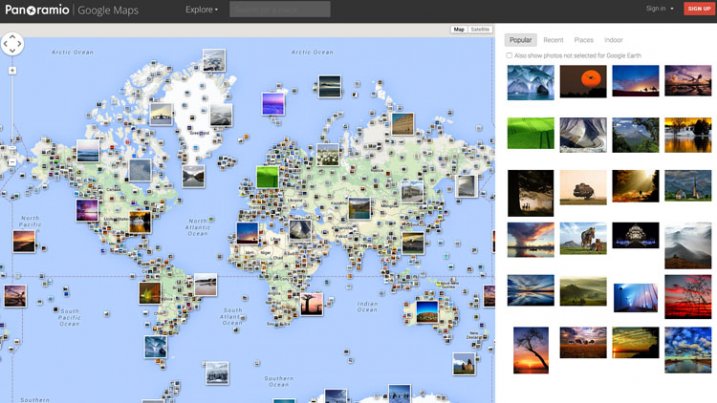
When it comes to sites like Flickr or Panoramio, or even apps like Stuck on Earth (which pulls its photographs from these sites) you’re able to see many years worth of photographs taken by dozens, if not hundreds, or even thousands of photographers. At first glance this might seem like a great resource, and to some extent it is, but there’s also a downside – namely you might get lost trying to mimic and forget to create.
Because you’re able to see so many photographs of a given location you may become so focused on a specific angle or idea from these photographs, that you forget to look for your own unique way to express the scene in question – and as a result your image may lose some originality.
2. The things a photo can’t tell you
A photograph on a website will give you some great ideas and insight into a location, but at the same time, it doesn’t tell you a lot of important things too. For example, you’ll have no idea how many attempts it took the photographer to find the right lighting conditions. You won’t know much about how difficult the location is to reach, or if that particular image required camping out to achieve the desired result.
3. You’re drawn to the best photography
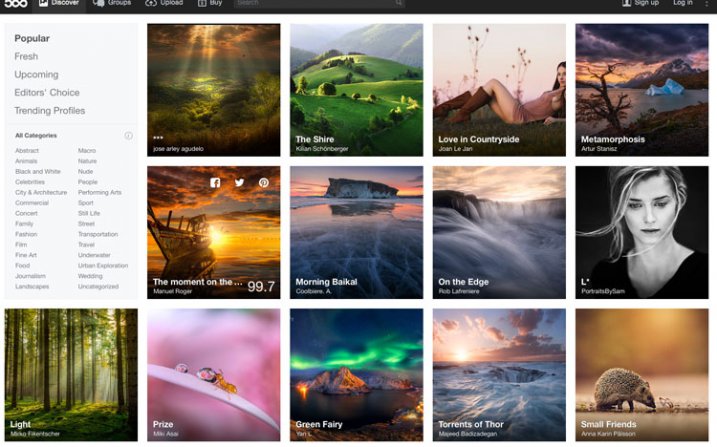
Not only are you naturally going to be drawn to the best photography on these sites, but they tend to push the best photography higher in searches and ranking, making it even more likely that’s what you’re going to see. Again, on the surface this might sound like a great thing because you’re able to see all the great possibilities that a given location has to offer – but there may be a downside here as well.
Think about this… how likely is it that these great photographs you’re seeing are from people who have visited a location just once? Most great photographs are planned, iterated upon, and purposefully shot. When you find a photograph on a site like this you’re looking at the best of the best, and as a result you’re seeing the best possible lighting conditions a scene might offer, which might not occur while your there.
In an article I’ve previously written for DPS titled Start feeling GOOD about YOUR photography I noted that it’s important that you don’t compare your work to someone else’s. This is particularly true for those who have more experience behind a camera than you, as it will only lead to disappointment.
I think that this advice can be extended to scouting for locations and inspiration as well. Setting the bar too high will only lead to stress and anxiety if you’re unable to produce results that live up to your expectations. This experience could leave you disappointed about your trip to a fantastic location – which had you gone in blind, may not have happened.
Final thoughts
I don’t want you to completely write off these resources, after all they do provide you with great inspiration and ideas. This isn’t an article designed to get you to stop using these sites, or even this technique for finding locations, but rather, to use it smarter. I hope this has given you something to think about. Please feel free to share your own thoughts in the comments section below.
googletag.cmd.push(function() {
tablet_slots.push( googletag.defineSlot( “/1005424/_dPSv4_tab-all-article-bottom_(300×250)”, [300, 250], “pb-ad-78623” ).addService( googletag.pubads() ) ); } );
googletag.cmd.push(function() {
mobile_slots.push( googletag.defineSlot( “/1005424/_dPSv4_mob-all-article-bottom_(300×250)”, [300, 250], “pb-ad-78158” ).addService( googletag.pubads() ) ); } );
The post 3 Downsides to Scouting New Photography Locations Online by John Davenport appeared first on Digital Photography School.
The Importance of Scouting for Landscape Photographers
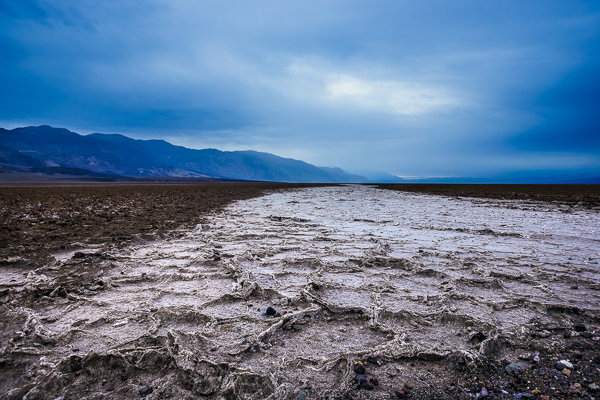
What Lies Beneath | West Side Road, Death Valley National Park
As I start writing this post, I’m sitting by my gate at Las Vegas McCarran International Airport. I loathe Vegas, but that’s beside the point. I managed to avoid the strip this time and will be home soon. I just wrapped up an incredible week leading a workshop in Death Valley National Park with my good buddy Brian Matiash and nine awesome students. This was my fifth trip to the park, and I’m starting to feel like I know the place like the back of my hand (even though there are still a several places I’d like to visit).
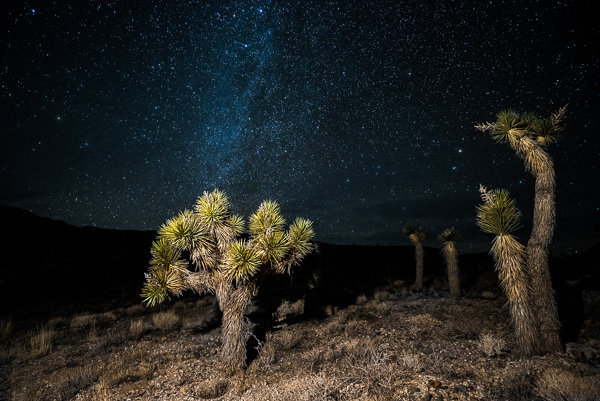
Joshua Trees in Death Valley
Ever since hearing about a lesser known area of the park known as Cottonball Basin (or Cottonball Marsh), I’ve been on the hunt for a certain kind of pattern found there. Cottonball Basin is hiding in plain site of virtually everyone who visits Death Valley. It’s located about five miles north of Furnace Creek off Highway 190, but there are no signs for it, and no areas for parking. You simply have to pull off into the gravel on the side of the road and start hiking out.
The trouble is that Cottonball Basin (and much of Death Valley) is always changing. Badwater Basin (which feeds into Cottonball) is an underground river, so the surface is always morphing and looks different with each visit. If you pick the wrong spot of the highway to pull over and start hiking, you could spend hours hiking around the marsh and find nothing.
During my last visit to the park (before this one), I hiked out to Cottonball twice and while I was able to come out with some decent shots, it wasn’t what I was looking for. I was never able to find the patterns I had seen in a few photos.
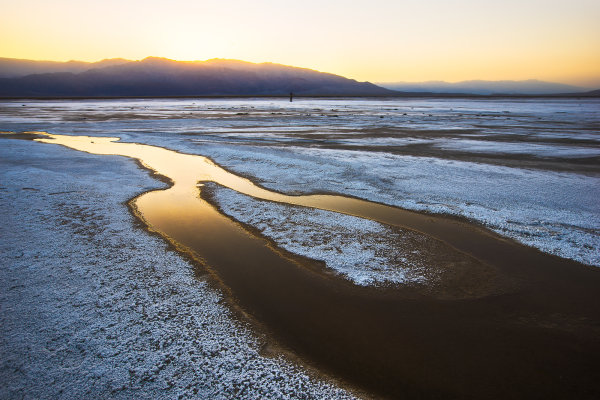
Even though I hadn’t found what I was looking for, there is still plenty of beauty to be found all over Cottonball Basin.
This time around, I was bound and determined not to come up empty handed. Right before heading out, I purchased a Garmin Oregon 600 Handheld GPS. I had a cheaper Garmin before, but it was so unintuitive and difficult to use that I wasn’t willing to risk using it again. The Oregon series is a touch screen model that is responsive, quickly acquires satellites, and is very easy to use and understand.
The day before the workshop began, Brian and I hiked out to Cottonball Basin. We found essentially nothing. I felt pretty defeated. We ended up changing the workshop itinerary and nixed Cottonball Basin altogether. It wasn’t until a chance encounter at Racetrack Playa that my luck would change.
As our group began exploring The Racetrack, Brian and I noticed a group of four photographers at one of the best rocks on the playa. They were taking turns standing on the rock, sitting on it, and taking all sorts of photos with them in it (probably for Instagram or something). This made my blood boil, so before too long, we went over and laid into them pretty good. They apologized for what they were doing and promised to stop (I really don’t understand that behaviour).
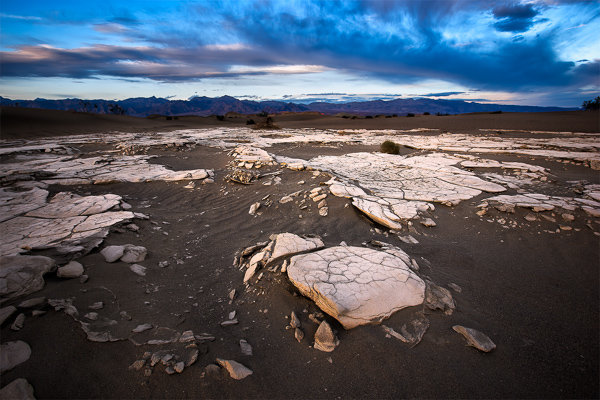
Mesquite Sand Dune Crust | Death Valley National Park
After going back later that evening (they stayed at that same rock the entire evening) we began chatting with the main guy from the group taking pictures. He mentioned that he found some good patterns at Cottonball and showed us the shots he took with his iPhone. These shots were the closest I’ve seen in a long time to the patterns I was looking for and he was nice enough to let us know where to find them. Unfortunately, we only had one last day of the workshop so we’d have to try our luck alone after the students had already left.
On the last day of our trip, after the workshop had concluded, we headed out again to explore and scout the basin. Using my Oregon 600, I dropped a pin at our parking spot off the highway and began hiking out. Around half a mile in, we saw some good patterns starting to forming (this was after walking over some very unwelcoming terrain that would probably cause most tourists and/or photographers to turn back). Things were starting to look good. As we kept hiking out, the patterns began getting tighter and tighter together. Finally, around 1.5 miles into the basin we hit the mother-load. I dropped around 7 pins at different locations out on the basin because I knew these spots were going to be difficult to find again. It’s hard to describe, but Cottonball Basin is a massive expanse of completely flat terrain for the most part. You can pick the same exact parking spot, but if you hike out 20 degrees to the left of where you found the patterns, you’ll miss your mark by enough to not even see something useful.
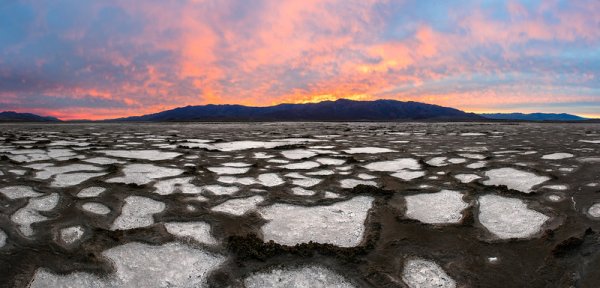
The shot I had been waiting thee years to get was finally mine. I wanted to capture as much as possible so I created this panoramic by taking five vertical images and stitching them together in PTGui Pro.
After lunch and a good nap, we headed out again for sunset. The Oregon 600 led us directly to the exact same spots we stood in earlier that da,y with plenty of time to spare for the light to be right. Oh man, did the light get right. Sunset that evening was one of the top three sunsets I’ve ever seen in my life (and I take ranking my sunsets pretty seriously).
If we hadn’t been relentlessly scouting this location, I’m quite confident I would still be in search of those patterns today.
Start to Finish Video Tutorial
Below is a video I put together from the trip. This is an in-depth video showing the scouting process, the sunset shoot, as well as the post-processing of the image once I got back home. Let me know if you have any questions!
googletag.cmd.push(function() {
tablet_slots.push( googletag.defineSlot( “/1005424/_dPSv4_tab-all-article-bottom_(300×250)”, [300, 250], “pb-ad-78623” ).addService( googletag.pubads() ) ); } );
googletag.cmd.push(function() {
mobile_slots.push( googletag.defineSlot( “/1005424/_dPSv4_mob-all-article-bottom_(300×250)”, [300, 250], “pb-ad-78158” ).addService( googletag.pubads() ) ); } );
The post The Importance of Scouting for Landscape Photographers by James Brandon appeared first on Digital Photography School.
Scouting and Paddling the South Platte River after 2013 Flooding
The river is the same as before 2013 flooding, wide open, without any unusual obstacles. More changes you can see on shores including river access.
Evans. Riverside Park, a popular launching place, is closed. I am not sure if it is related to the flooding or just temporary closure due to winter/muddy conditions. No information on their website.
37th street bridge in Evans (left shore, upstream) may be an alternative launching spot with off road parking. It is just below the Riverside Park. Right now, the place is very muddy with a lot of fresh dirt after the bridge repairs. SWA below the bridge is closed.
Kersey access remains the same (not too easy for larger groups).
Kuner access remains the same.
The river flow is good, above 1000cfs, all the way to Fort Morgan. Most dams below Kuner were upgraded with gates during recent years. They may be paddleable if not diverting water. The dam below Kuner (Empire Reservoir inlet) was closed yesterday.
Only a little bit of snow was left on sandbars. Turkey were very talkative and loud. I saw a whitetail deer crossing the river – it had to swim across the main channel.

Pixel, the “water” Corgi in Sea Wind canoe

South Platte River above Kuner, February 2014

South Platte River above Kuner, February 2014

South Platte River above Kuner, February 2014
Related posts:
South Platte River below Denver – GPS/photo river guide
12th Annual South Platte River All Club Paddle
Opening 2014 Paddling Season on the South Platte River
You must be logged in to post a comment.